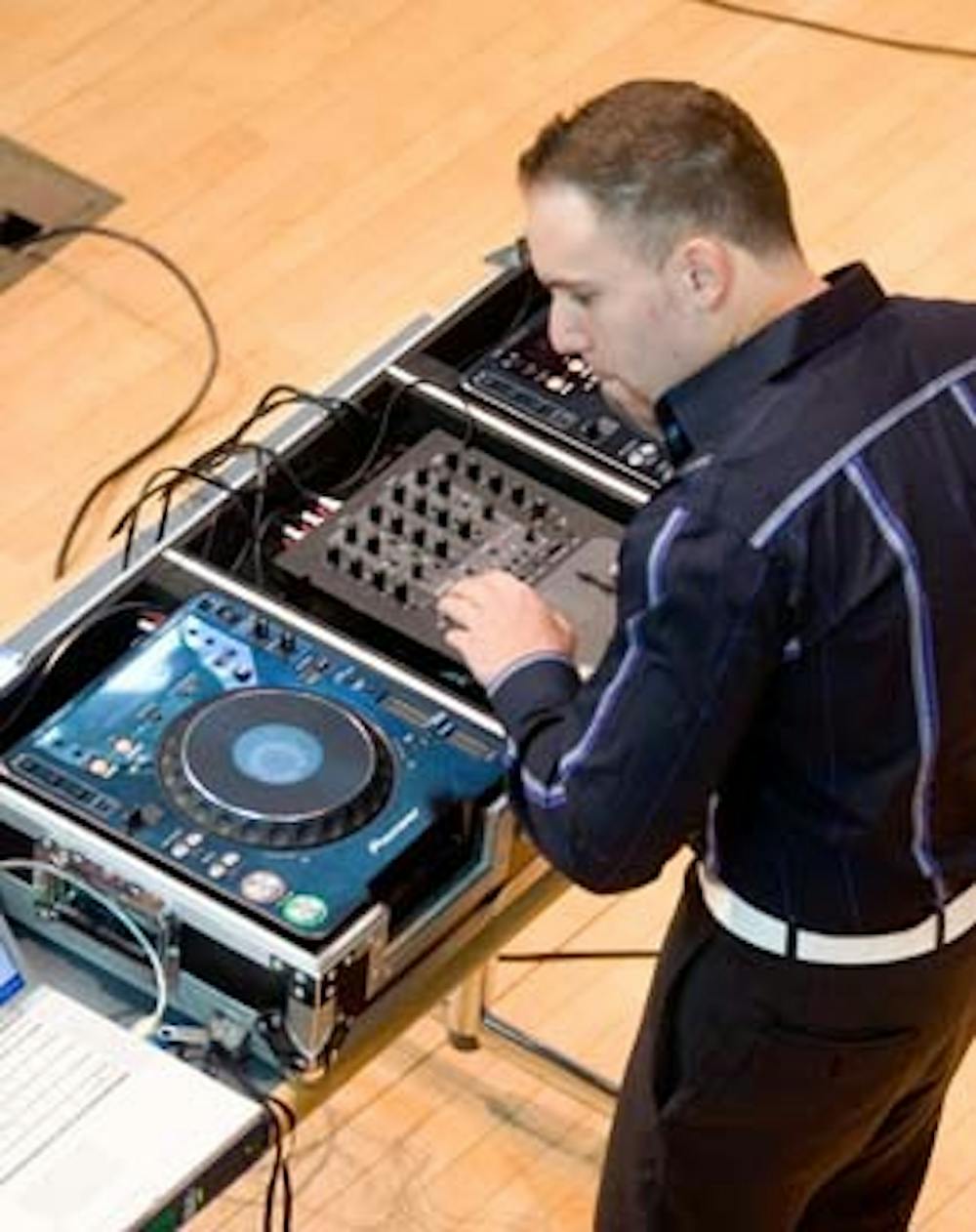A helicopter roars overhead, disrupting the insectoid buzz that fills the air of an invisible, unknown wilderness. In its wake, a keening voice rises, singing parts of an ancient song without words. And, in the middle of the room, a computer monitor tracks the course of it all. Seated next to the monitor, composer Kati Gleiser works the soundboard, balancing the voice and accordion samples that make up "Infiltration," her lament for Western civilization's invasion of nomadic culture. \nThis isn't your grandma's accordion music.\nLast Saturday in Auer Concert Hall, the IU Center for Electronic and Computer Music held the most recent of its biannual computer music recitals. One by one, students from the Center's Projects In Electronic Music course offered up the fruits of their labor, ranging from chilly abstract soundscapes to computer-accompanied acoustic performances to a thundering paean to the return of a deposed Toltec god.\n"Electronic music is capable of creating sounds that have never existed before and organizing them on a micro-montage level," said graduate student Adam Haws, although he also noted that he does not see a significant difference between electronic and acoustic composition. Indeed, true to form, Haws' composition "From Inner Shadow," a work inspired by Russian director Andrei Tarkovsky's 1979 film "Stalker," uses original acoustic chamber music recordings manipulated via the free software program RTcmix.\nBut while the technology might be cutting edge, the Center for Electronic and Computer Music has been at IU for more than 40 years. Established in 1966 by influential modernist composer Iannis Xenakis, the Center has evolved with the growth of computing power -- from using the campus' large mainframe computer, magnetic tape and punch cards to laptops, digital recording and software that even people without computer science degrees can use. And with IU President Michael McRobbie's recent creation of an Institute for the Digital Arts and Humanities to support faculty research projects, the University hopes to push the envelope even further.\n"Everything is becoming more and more accessible to the composer," said Prof. Jeffrey Hass, director of the Center and 2008 Institute fellow, citing the greater affordability of advanced music technology. "We can take a sound and break it down into its component frequencies, change them, transpose them and lower their pitch without shortening them. Sound is now digital, so we have fancy mathematical formulas to replace analog circuits." \nOne of the computer music recital's most dramatic examples of these capabilities was "Quetzel," a composition by graduate student William Guerin. Inspired by part of José Clemente Orozsco's mural "The Epic of American Civilization" -- specifically, the panel depicting the Toltec myth of the god Quetzalcoatl's banishment from the pre-Columbian Americas on a raft of serpents -- Guerin's song tells the story of the god's apocalyptic homecoming via terrifying drips, crackles, howls and booms. But behind the mighty tumult are surprisingly mundane sources.\n"Most of the sounds actually came from a (seventh-grade) clarinet that was sitting in my parents' house." Guerin said. "I hadn't touched it in years and years and years, and while I was home my mom actually wanted to bring it to Goodwill. And I thought, 'Well, maybe I can find a use for this.'" \nMeanwhile, the crackling noises that open "Quetzel" came from an even humbler source: tortilla chips and pretzels.\nBut not all the performances were a matter of playing prerecorded pieces. \nFor "A Cycle of Fallacy for Soprano, Disc Jockey and Live Electonics," composer Mark Oliveiro took to the stage with a digital music mixer and laptop to manipulate the live vocals of soprano Suna Avci. As Avci sung passages from New York poet Dylan Reid Pancer's "The Physical Impossibility of Death in the Mind of Someone Living," Oliveiro reshaped them, combining them with 14 separate prerecorded tape parts. Prior to the performance, he explained that, for his work, he likes to record a piece of music into sound files, manipulate them via synthesizing and editing software, then play them back over the original source.\n"I believe (electronic music) to be the future of where art music is going, because there's no end to the development of the technology," Oliveiro said. "You can't go for a month without there being some new program or new device that you can use to enhance your music ... Art music, I think, will be written on the back of electronic media."\nAfter pitting Westernization's helicopter against the eerie melodies of vocalist Dan Bubeck, graduate student Kati Gleiser discussed her interest in electronic music, framing it in even grander terms.\n "It's relatively new. So, as a performer/composer/improviser, I feel like it's endless, the boundaries ... " she said, "Also the technologization of human beings -- we've become such a technological culture. In that way, it's much more holistic; it's not back to the woods thinking"
Do you compute?
Computer music artists perform songs inspired by everything from nomadic culture to Quetzalcoatl

Get stories like this in your inbox
Subscribe





